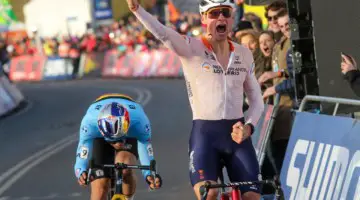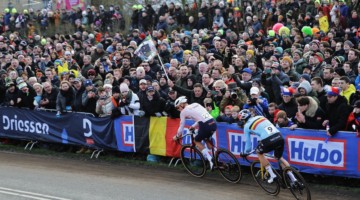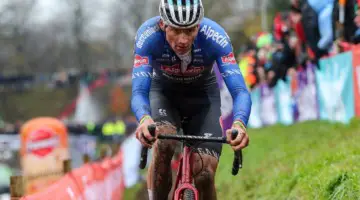At the Brico Cross Vestingcross Hulst, Wout van Aert once again finished second to Mathieu van der Poel. The World Champ is still on the hunt for his first win after his stunning 2017 Cyclocross World Championships, but can avoid worries about the rainbow jersey curse, having won plenty of races in rainbow stripes in 2016, including both American World Cups.
Christine Vardaros caught up with Van Aert in Hulst for a lengthy interview that covered many topics. Van Aert weighed in on his second Worlds title, his much talked-about green Michelin Mud tubulars, team manager Niels Albert’s influence, Worlds course designers and compares his new sponsor Felt Bicycle’s cyclocross bike to his prior CrossVegas-winning Colnago Prestige.
We have some highlighted excerpts with the full video interview below.
On his mental preparation for Worlds:
Mental preparation is a timely topic, and coach Chris Mayhew covered the mental training aspects in his latest Training Tuesday column on mindfulness, and Van Aert values the mental aspect of racing and training.
“[Even] without knee problems, it’s important to have good mental strength before such a race, but right now it was [a] different way of preparation. We tried to not think about preparation and [tried] to start this race with an open mind and just go all out for an hour and ‘Let’s see what will happen without expectations.'”
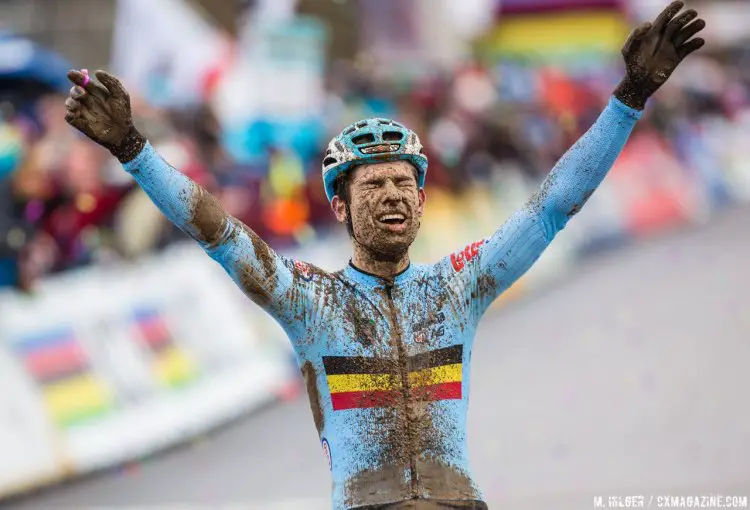
Wout van Aert is in disbelief with his title defense when he started without expectations. Elite Men. 2017 UCI Cyclocross World Championships, Bieles, Luxembourg. © M. Hilger / Cyclocross Magazine
On his title defense and comparing the second title to the first:
“It was a tough period before the World Championships, and when I crossed the finish line, I really enjoyed that moment. Now it was more easy, and more [enjoyable] without really a lot of screaming…”
On his equipment preparation and choices for Worlds:
“It’s an idea from Niels [Albert]. He knew these tires from his youth when he came into cyclocross as a young rider, this was a very popular tire. But afterwards there came new tires that were a lot [softer] and they have a lot less resistance. So everybody has forgotten about the old green tires that were very stiff and have a lot of resistance when you’re riding through the mud. But it’s still a good tire to ride on snow and icy conditions. We wanted to have this one for the case that conditions were snowy.
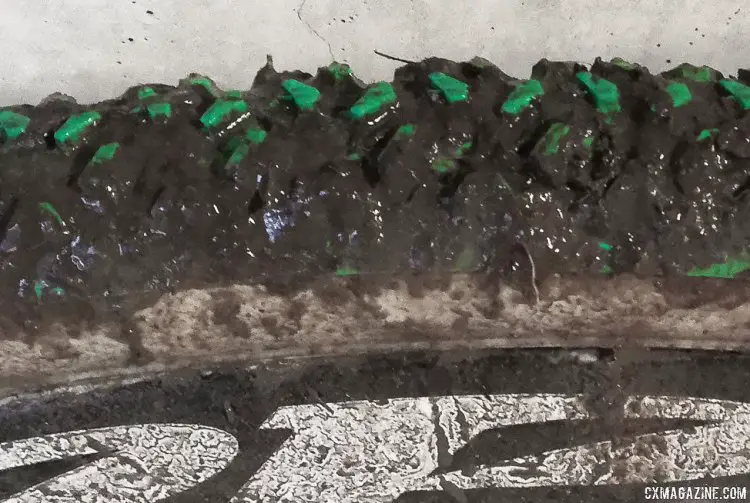
Wout van Aert’s green Michelin Mud treads on Dugast casings used to win the 2017 UCI Cyclocross World Championships. Bieles, Luxembourg. © Cyclocross Magazine
“When I go to recon on the day at the course, there wasn’t snow anymore, so I tried them, but afterwards I [went] to the normal mud tires we use, but I already felt there were a lot of stones, and I did only one lap with the normal tires and there were a lot of times when I hit the rim when hitting rocks and I had a completely different feeling with the green tires, where that wasn’t the case, so I then I decided to ride the green tires. In the end it was a good decision, but you also need a lot of power for it because it’s really tough to ride these tires, so yeah, it was also mentally difficult to keep on riding with them even after a really bad start and a bad feeling in the beginning.”
“I did only one lap with the normal tires and there were a lot of times when I hit the rim when hitting rocks and I had a completely different feeling with the green tires, where that wasn’t the case, so I then I decided to ride the green tires”
Wout confirmed much of the details in our in-depth post-Worlds report on his attention-grabbing green tires, although diminished the possibility that tire pressure was a big factor in his lack of flats, instead pointing to what we described as “a less-supple, more-reinforced layer underneath the tread” as a key to avoid flats.
Wout Van Aert’s Green Tires: Smart Flat Protection or Good Luck?
Although Van Aert’s father mentioned “a bit higher” pressures, it’s all relative. His pressure was 1.3 bar (18.85 psi) in the front and 1.4 bar (20.3 psi) in the back, which was slightly higher than normal but far from high and much lower than most (similar sized) racers run. It’s a lot less than the pressure Van Aert used for the thick grass of CrossVegas.
On Niels Albert’s role in his success:
Van Aert was gracious and quick to give credit to his team manager. “He has a very big role in [my success],” he said. “He always thinks about things that I don’t think about, like the tires, or places where we are going to train [specifically] for the World Championships or other championships. He’s really into the details and he can keep me very calm before the races because he knows what it is to be in the front of an important race so he knows what to say in the last moment.”
“He’s really into the details and he can keep me very calm before the races because he knows what it is to be in the front of an important race so he knows what to say in the last moment.”
On Adri van der Poel designing the 2017 Cyclocross World Championships course.
Van Aert both dismissed and furthered the controversy surrounding Adrie van der Poel designing the course his sons would race on. “It was just commotion before the race, before Worlds, every year it is the same, but when you see Mathieu has the most bad luck, it’s impossible that Adrie made a course that wasn’t good for him. It’s the best proof that…it’s stupid that they talk about it.”
But then he admitted he didn’t love the situation, saying, “My opinion is that it’s pretty strange that he’s allowed to design a course for Worlds, but on the other hand, he has a lot of experience and he’s [made] beautiful tracks in the past, we need these guys to keep making good tracks.”
On his new Felt compared to his Colnago Prestige:
“It’s a dangerous question [laughs]. Of course my Felt bike…I really like it because I have a feeling that the frame size [and] geometry really suit me.
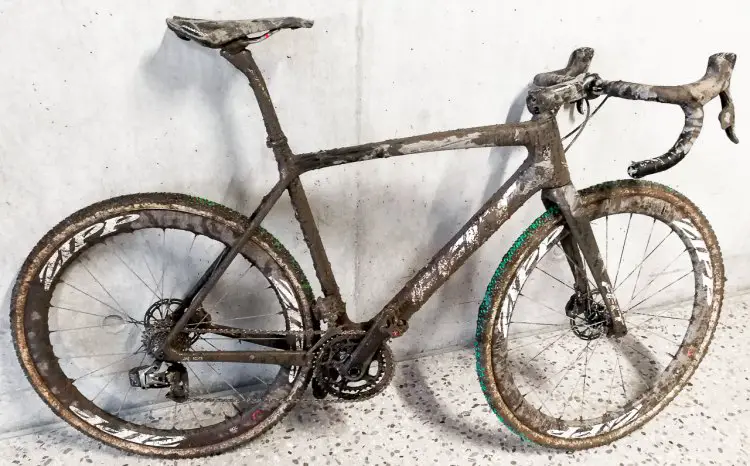
Wout van Aert’s 2017 Worlds-winning Felt cyclocross bike. 2017 Cyclocross World Championships bikes. © Cyclocross Magazine
“I feel better than on the Colnago which was a little too small I think but these bikes are very similar in weight and strength.”
The 6-foot-tall Van Aert rides a 55cm Felt, with a 56.5cm top tube (horizontal) and 39.7cm reach, which he says is about 1cm longer than his Colnago (likely the 52cm Prestige with a 55cm top tube and 386cm reach).
Watch the full video Wout van Aert interview below. See our recent interview with American Katie Compton here.

























